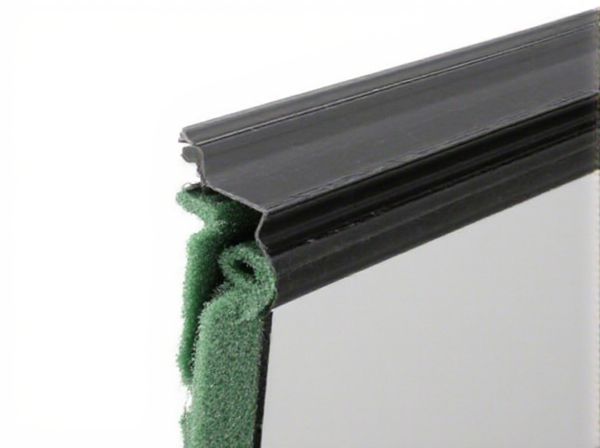
Photo illustration: Window Channel Felt vs Rubber Weatherstrip
Window channel felt provides a soft, fabric-like barrier that reduces friction and noise between the window glass and frame, enhancing smooth operation. Rubber weatherstrips offer superior sealing against water, dust, and air infiltration, improving insulation and energy efficiency. Choosing the right material depends on whether you prioritize quieter window movement or better weather resistance for your vehicle or building.
Table of Comparison
| Feature | Window Channel Felt | Rubber Weatherstrip |
|---|---|---|
| Material | Dense felt fabric | Flexible, durable rubber |
| Function | Reduces window rattling and seals gaps | Provides airtight, water-tight seal |
| Durability | Moderate; prone to wear and compression | High; resists weather, cracking, and UV damage |
| Noise Reduction | Good; dampens vibrations | Excellent; blocks wind and road noise |
| Weather Resistance | Limited; can absorb moisture | Superior; waterproof and weatherproof |
| Maintenance | Requires occasional replacement | Low maintenance; long-lasting |
| Cost | Lower initial cost | Higher initial cost |
| Best Use | Classic cars, interior noise reduction | Modern vehicles, full weather sealing |
Introduction to Window Channel Felt and Rubber Weatherstrip
Window channel felt and rubber weatherstrip are essential components for sealing vehicle windows, preventing water, dust, and air infiltration. Window channel felt consists of dense, fibrous material designed to provide smooth window operation and reduce noise, while rubber weatherstrips create a flexible, airtight seal offering superior insulation and durability. Both materials enhance cabin comfort and protect against environmental elements, but they serve distinct functions in automotive sealing systems.
Key Differences Between Window Channel Felt and Rubber Weatherstrip
Window channel felt primarily acts as a cushioning barrier that reduces noise and vibration while allowing slight window movement, featuring a soft, fibrous texture for sealing gaps. In contrast, rubber weatherstrip provides a more rigid and airtight seal, effectively preventing water, dust, and air infiltration with its durable and flexible material. Key differences lie in material composition, sealing effectiveness, and suitability for weather resistance versus soundproofing within automotive and architectural window systems.
Material Composition and Durability
Window channel felt is typically made from dense polyester or wool fibers, providing a soft barrier that reduces noise and prevents dust infiltration, though it may degrade faster under constant exposure to moisture. Rubber weatherstrips consist of EPDM (ethylene propylene diene monomer) or silicone rubber, known for superior elasticity and resistance to UV rays, ozone, and temperature extremes, resulting in enhanced durability and longer lifespan. The choice between these materials impacts the longevity and effectiveness of window sealing, with rubber weatherstrips offering more robust protection against environmental wear.
Installation Process: Window Channel Felt vs Rubber Weatherstrip
Window channel felt installs by sliding into the metal frame channel of the window, requiring precise measurement and trimming to fit securely without gaps, which can be time-consuming but ensures a snug seal. Rubber weatherstrips typically feature adhesive backing or a snap-on design, allowing for quicker and easier installation directly onto window edges with minimal tools. The felt demands more careful handling to avoid tearing, while rubber weatherstrips offer greater flexibility and durability during the installation process.
Performance in Noise Reduction
Window channel felt offers moderate noise reduction by cushioning the glass and blocking drafts, but it tends to compress over time, reducing its effectiveness. Rubber weatherstrips provide superior noise insulation due to their dense, flexible material that creates an airtight seal, effectively blocking external noise and vibration. In terms of long-term performance, rubber weatherstrips maintain their noise-reducing properties better than felt, making them the preferred choice for enhanced soundproofing.
Energy Efficiency and Insulation Comparison
Window channel felt offers moderate insulation by sealing small gaps around windows, reducing drafts and some heat loss, but its porous nature limits overall energy efficiency. Rubber weatherstrips provide superior energy efficiency and insulation due to their dense, flexible material that creates an airtight seal, effectively blocking air infiltration and moisture. When optimizing for thermal performance and energy savings, rubber weatherstrips outperform channel felt by maintaining consistent indoor temperatures and lowering heating and cooling costs.
Maintenance Requirements and Longevity
Window channel felt requires regular inspection and occasional replacement due to its susceptibility to wear and moisture damage, leading to frequent maintenance needs. Rubber weatherstrips offer superior durability and resistance to environmental factors such as UV light, temperature changes, and moisture, resulting in lower maintenance demands and extended lifespan. Proper installation and occasional cleaning of rubber weatherstrips can ensure maximum longevity, often lasting several years longer than felt alternatives.
Cost Analysis: Window Channel Felt vs Rubber Weatherstrip
Window channel felt generally costs less than rubber weatherstrip, making it a more budget-friendly option for sealing car windows. Rubber weatherstrips, while pricier, offer superior durability and longer lifespan, reducing replacement frequency and long-term expenses. Considering installation costs and maintenance, rubber weatherstrip provides better value over time despite the higher initial investment.
Best Applications for Each Weatherproofing Solution
Window channel felt provides effective cushioning and sound insulation ideal for older windows in historic homes or vintage vehicles, ensuring smooth sash movement and reducing rattles. Rubber weatherstrips offer superior moisture sealing and durability, making them the preferred choice for exterior doors and modern window frames exposed to harsh weather conditions. Selecting felt for restoration projects emphasizes maintaining original aesthetics, while rubber excels in energy efficiency and long-term weather resistance.
How to Choose Between Window Channel Felt and Rubber Weatherstrip
Choosing between window channel felt and rubber weatherstrip depends on factors such as durability, sealing efficiency, and vehicle type. Window channel felt offers a softer, quieter seal ideal for older cars or those emphasizing noise reduction, while rubber weatherstrip provides superior weather resistance, preventing water and air leaks more effectively in various climates. Prioritize rubber weatherstrip for heavy-duty protection and longevity, whereas window channel felt suits applications requiring gentle cushioning and reduced window rattling.
 caratoz.com
caratoz.com